Research on the Sustainable Development of Natural-Social-Economic Systems Based on the Emergy Accounting Method—A Case Study of Liyang in China
Abstract
:1. Introduction
2. Materials and Methods
2.1. Study Area and Data Source
2.2. The Emergy Accounting Method
2.2.1. Emergy Flows
2.2.2. Emergy Accounting
2.2.3. The Natural–Social–Economic Sustainable Development Evaluation System
2.3. Entropy Weighting Method
- Define the positive and negative of each index, and standardize the data:
- 2.
- Calculate the entropy value of each index:
- 3.
- Measure the weight of each index:
- 4.
- Calculation of the sustainability composite index Fi:
3. Results
3.1. The Emergy Accounting Results in Liyang
3.1.1. Overview of Emergy Flows and Emergy Accounting Results
3.1.2. Analysis of Input Structure
- (1)
- Renewable inputs or non-renewable inputs?
- (2)
- Emergy from natural resources and investment emergy from the social–economic system
- (3)
- Emergy input structure based on industrial structure
- (4)
- Analysis of emergy input structure from the perspective of production factors
3.1.3. Analysis of Output Structures
- (1)
- The output structures
- (2)
- The production efficiency based on the output structure
3.1.4. Analysis of Waste Emergy Structure
3.2. The Sustainable Assessment of Liyang Natural–Social–Economic System Based on EWM
4. Discussion
4.1. Input Structure, Input–Output Efficiency, and Sustainable Production and Consumption
4.2. Environmental Impact and Regional Green Development
4.3. Comparisons and Potential Applications of the Evaluation System and Methodology
5. Conclusions
Author Contributions
Funding
Institutional Review Board Statement
Informed Consent Statement
Data Availability Statement
Conflicts of Interest
References
- Colglazier, W. Sustainable development agenda: 2030. Science 2015, 349, 1048–1050. [Google Scholar] [CrossRef] [PubMed]
- Yang, Q.; Liu, G.; Giannetti, B.F.; Agostinho, F.; Almeida, C.M.; Casazza, M. Emergy-based ecosystem services valuation and classification management applied to China’s grasslands. Ecosyst. Serv. 2020, 42, 101073. [Google Scholar] [CrossRef]
- Liu, Z.J.; Li, B.; Chen, M.Y.; Li, T. Evaluation on sustainability of water resource in karst area based on the emergy ecological footprint model and analysis of its driving factors: A case study of Guiyang city, China. Environ. Sci. Pollut. Res. 2021, 28, 49232–49243. [Google Scholar] [CrossRef]
- Liu, L.; Di, B.F.; Zhang, M.Y. The tradeoff between ecological protection and economic growth in China’s county development: Evidence from the soil and water conservation projects during 2011–2015. Resour. Conserv. Recycl. 2020, 156, 104745. [Google Scholar] [CrossRef]
- Liu, Y.; Qiao, J.J.; Xiao, J.; Han, D.; Pan, T. Evaluation of the Effectiveness of Rural Revitalization and an Improvement Path: A Typical Old Revolutionary Cultural Area as an Example. Int. J. Environ. Res. Public Health 2022, 19, 13494. [Google Scholar] [CrossRef]
- Xu, Y.N.; Wang, T.; Liu, W.J.; Zhang, R.F.; Hu, Y.M.; Gao, W.S.; Chen, Y.Q. Rural system sustainability evaluation based on emergy analysis: An empirical study of 321 villages in China. J. Clean. Prod. 2023, 389, 136088. [Google Scholar] [CrossRef]
- Wang, Z.H.; Yang, L.; Yin, J.; Yin, J.H.; Zhang, B. Assessment and prediction of environmental sustainability in China based on a modified ecological footprint model. Resour. Conserv. Recycl. 2018, 132, 301–313. [Google Scholar] [CrossRef]
- Li, J.X.; Chen, Y.N.; Xu, C.C.; Li, Z. Evaluation and analysis of ecological security in arid areas of Central Asia based on the emergy ecological footprint (EEF) model. J. Clean. Prod. 2019, 235, 664–677. [Google Scholar] [CrossRef]
- Patterson, T.; Gulden, T.; Cousins, K.; Kraev, E. Integrating environmental, social and economic systems: A dynamic model of tourism in Dominica. Ecol. Model. 2004, 175, 121–136. [Google Scholar] [CrossRef]
- Yli-Pelkonen, V.; Niemelä, J. Linking ecological and social systems in cities: Urban planning in Finland as a case. Biodivers. Conserv. 2005, 14, 1947–1967. [Google Scholar] [CrossRef]
- Melgar-Melgar, R.E.; Hall, C.A. Why ecological economics needs to return to its roots: The biophysical foundation of socio-economic systems. Ecol. Econ. 2020, 169, 106567. [Google Scholar] [CrossRef]
- Barles, S. Society, energy and materials: The contribution of urban metabolism studies to sustainable urban development issues. J. Environ. Plan. Manag. 2010, 53, 439–455. [Google Scholar] [CrossRef]
- Wolfslehner, B.; Vacik, H. Evaluating sustainable forest management strategies with the Analytic Network Process in a Pressure-State-Response framework. J. Environ. Manag. 2008, 88, 1–10. [Google Scholar] [CrossRef] [PubMed]
- Nakajima, E.S.; Ortega, E. Carrying capacity using emergy and a new calculation of the ecological footprint. Ecol. Indic. 2016, 60, 1200–1207. [Google Scholar] [CrossRef]
- Chen, H.S. Evaluation and analysis of eco-security in environmentally sensitive areas using an emergy ecological footprint. Int. J. Environ. Res. Public Health 2017, 14, 136. [Google Scholar] [CrossRef] [Green Version]
- Hester, J., Jr. Systems Analysis for Social Policies: Urban Dynamics. Jay W. Forrester. MIT Press, Cambridge, Mass. 1969. xiv+ 290, pp., illus. $12.50. Science 2017, 168, 693–694. [Google Scholar] [CrossRef]
- Qian, L.Y.; Wang, F.F.; Cao, W.; Ding, S.; Cao, W.Z. Ecological health assessment and sustainability prediction in coastal area: A case study in Xiamen Bay, China. Ecol. Indic. 2023, 148, 110047. [Google Scholar] [CrossRef]
- Ostrom, E. A general framework for analyzing sustainability of social-ecological systems. Science 2009, 325, 419–422. [Google Scholar] [CrossRef]
- Odum, H.T. Systems Ecology: An Introduction; John Wiley and Sons: New York, NY, USA, 1983. [Google Scholar]
- Odum, H.T.; Brown, M.T. Carrying Capacity for Man and Nature in South Florida, Final Report to National Park Service; US Department of Interior and State of Florida, Division of State Planning: Gainesville, FL, USA, 1975.
- Lotka, A.J. Contribution to the energetics of evolution. Proc. Natl. Acad. Sci. USA 1922, 8, 147–151. [Google Scholar] [CrossRef]
- Ulgiati, S.; Brown, M.T.; Bastianoni, S.; Marchettini, N. Emergy-based indices and ratios to evaluate the sustainable use of resources. Ecol. Eng. 1995, 5, 519–531. [Google Scholar] [CrossRef]
- Brown, M.T.; Ulgiati, S. Energy quality, emergy, and transformity: HT Odum’s contributions to quantifying and understanding systems. Ecol. Model. 2004, 178, 201–213. [Google Scholar] [CrossRef]
- Chen, G.Q. Exergy consumption of the earth. Ecol. Model. 2005, 184, 363–380. [Google Scholar] [CrossRef]
- Jørgensen, S.E.; Nielsen, S.N.; Mejer, H. Emergy, environ, exergy and ecological modelling. Ecol. Model. 1995, 77, 99–109. [Google Scholar] [CrossRef]
- Liu, G.Y.; Yang, Z.F.; Chen, B.; Zhang, Y.; Zhang, L.X.; Zhao, Y.W.; Jiang, M.M. Emergy-based urban ecosystem health assessment: A case study of Baotou, China. Commun. Nonlinear Sci. Numer. Simul. 2009, 14, 972–981. [Google Scholar] [CrossRef]
- Zhang, L.X.; Chen, B.; Yang, Z.F.; Chen, G.Q.; Jiang, M.M.; Liu, G.Y. Comparison of typical mega cities in China using emergy synthesis. Commun. Nonlinear Sci. Numer. Simul. 2009, 14, 2827–2836. [Google Scholar] [CrossRef]
- Rugani, B.; Huijbregts, M.A.; Mutel, C.; Bastianoni, S.; Hellweg, S. Solar energy demand (SED) of commodity life cycles. Environ. Sci. Technol. 2011, 45, 5426–5433. [Google Scholar] [CrossRef]
- Zhang, J.X.; Ma, L. Urban ecological security dynamic analysis based on an innovative emergy ecological footprint method. Environ. Dev. Sustain. 2021, 23, 16163–16191. [Google Scholar] [CrossRef]
- Wang, Y.; Zhu, Y.; Yu, M. Measuring the implementation effects of rural revitalization in China’s Jiangsu Province: Under the analytical framework of “deconstruction, assessment and brainstorming”. Growth Chang. 2022, 53, 1146–1169. [Google Scholar] [CrossRef]
- Yao, X.C.; Chen, W.W.; Song, C.C.; Gao, S.Q. Sustainability and efficiency of water-land-energy-food nexus based on emergy-ecological footprint and data envelopment analysis: Case of an important agriculture and ecological region in Northeast China. J. Clean. Prod. 2022, 379, 134854. [Google Scholar] [CrossRef]
- Pan, X.F.; Guo, S.C. Dynamic decomposition and regional differences of urban emergy ecological footprint in the Yangtze River Delta. J. Environ. Manag. 2023, 326, 116698. [Google Scholar] [CrossRef]
- Du, Y.W.; Wang, Y.C.; Li, W.S. Emergy ecological footprint method considering uncertainty and its application in evaluating marine ranching resources and environmental carrying capacity. J. Clean. Prod. 2022, 336, 130363. [Google Scholar] [CrossRef]
- Liu, G.Y.; Yang, Z.F.; Chen, B.; Ulgiati, S.G. Emergy-based dynamic mechanisms of urban development, resource consumption and environmental impacts. Ecol. Model. 2014, 271, 90–102. [Google Scholar] [CrossRef]
- Fang, W.; An, H.Z.; Li, H.J.; Gao, X.Y.; Sun, X.Q.; Zhong, W.Q. Accessing on the sustainability of urban ecological-economic systems by means of a coupled emergy and system dynamics model: A case study of Beijing. Energy Policy 2017, 100, 326–337. [Google Scholar] [CrossRef]
- Hoekstra, A.Y.; Wiedmann, T.O. Humanity’s unsustainable environmental footprint. Science 2014, 344, 1114–1117. [Google Scholar] [CrossRef]
- Lu, H.F.; Ye, Z.; Zhao, X.F.; Peng, S.L. A new emergy index for urban sustainable development. Sheng Tai Xue Bao 2003, 23, 1363–1368. (In Chinese) [Google Scholar]
- Lei, K.; Wang, Z. Emergy synthesis and simulation for Macao. Energy 2008, 33, 613–625. [Google Scholar] [CrossRef]
- Sergio, U.; Mark, T.B. Monitoring patterns of sustainability in natural and man-made ecosystems. Quat. Int. 1998, 108, 23–36. [Google Scholar]
- Wang, C.; Liu, F.; Wang, Y. Emergy-based comparative analysis of an ecological economy in the Yangtze River Delta. Environ. Eng. Res. 2023, 28, 210325. [Google Scholar] [CrossRef]
- Xiao, X.; Wang, Q.; Guan, Q.; Shao, W.; Luo, H.; Shan, Y.; Mi, J. Assessing the sustainability of ecosystems over fourteen years of cultivation in Longnan City of China based on emergy analysis method. J. Environ. Manag. 2022, 307, 114513. [Google Scholar] [CrossRef] [PubMed]
- Lan, S.F.; Qin, P. Energy Value Analysis of Ecological Economic System; Chemical Industry Press: Beijing, China, 2002; Volume 407, pp. 35–36. (In Chinese) [Google Scholar]
- Brahmasrene, T.; Lee, J.W. Assessing the dynamic impact of tourism, industrialization, urbanization, and globalization on growth and environment in Southeast Asia. Int. J. Sustain. Dev. World Ecol. 2017, 24, 362–371. [Google Scholar] [CrossRef]
- Odum, H.T. Environmental Accounting: Emergy and Environmental Decision Making; John Wiley and Sons: New York, NY, USA, 1996. [Google Scholar]
- Xu, Y.; Huang, H.S.; Yuan, G. Analysis of Ecological Security Changes in Hilly Areas Based on Emergy Ecological Footprint: Case Study of Jiujiang City, Jiangxi Province. Sci. Technol. Eng. 2021, 21, 6081–6088. (In Chinese) [Google Scholar]
- Huang, H.; Shi, Y.; Ran, S.S.; Su, H.R.; Liu, J.E. Dynamic research on sustainable development of farmland-livestock production system based on emergy theory. J. Nat. Resour. Policy Res. 2020, 35, 869–883. (In Chinese) [Google Scholar] [CrossRef]
- Zhu, Y.L.; Li, M.J.; Hou, M.Z.; Long, Y.Z.; Wang, M.X. Analysis of Emergy Structure, Function and Efficiency of Agro-ecosystem in Hunan Province. Agric. Sci. Technol. 2013, 14, 186. (In Chinese) [Google Scholar]
- Zhao, Y.; Ma, J.; Li, X.F.; Yu, M. Optimization and Application of Emergy Ecological Footprint Model Based on Account System: Taking Liaoning Province as an Example. Ecol. Econ. 2022, 11, 161–166+208. (In Chinese) [Google Scholar]
- Yu, F.; Li, X.B.; Wang, H.; Zhang, L.J.; Xu, W.H.; Fu, R. Accounting of Gross Ecosystem Product based on emergy analysis and ecological land classification in China. Acta Ecol. Sin. 2016, 36, 1663–1675. [Google Scholar]
- Jia, X.L.; Zhou, Y.; Yan, J.L.; Wei, Y.G. Sustainable development of an ecological-economic system in the Taihu Lake city cluster based on emergy analysis. Acta Ecol. Sin. 2019, 39, 6487–6499. (In Chinese) [Google Scholar]
- Liu, H.G.; Dong, X.C. Emergy Structure, Efficiency and Driving Factors of Agricultural Input and Output in the Yangtze River Economic Belt. Chin. Agric. Sci. Bull. 2022, 38, 130–138. (In Chinese) [Google Scholar]
- Sun, X.R.; Shui, W.; Zheng, J.Y.; Tao, Y.; Li, H. Evaluation of metabolic sustainability in Xiamen based on emergy analysis. Acta Ecol. Sin. 2021, 41, 4342–4353. (In Chinese) [Google Scholar]
- Zhao, Z.Q.; Li, S.C.; Gao, Y. Emergy-based modification for ecological footprint accounting and application to open eco-economic system: A case study of Shenzhen City. Acta Ecol. Sin. 2008, 28, 2220–2231. (In Chinese) [Google Scholar]


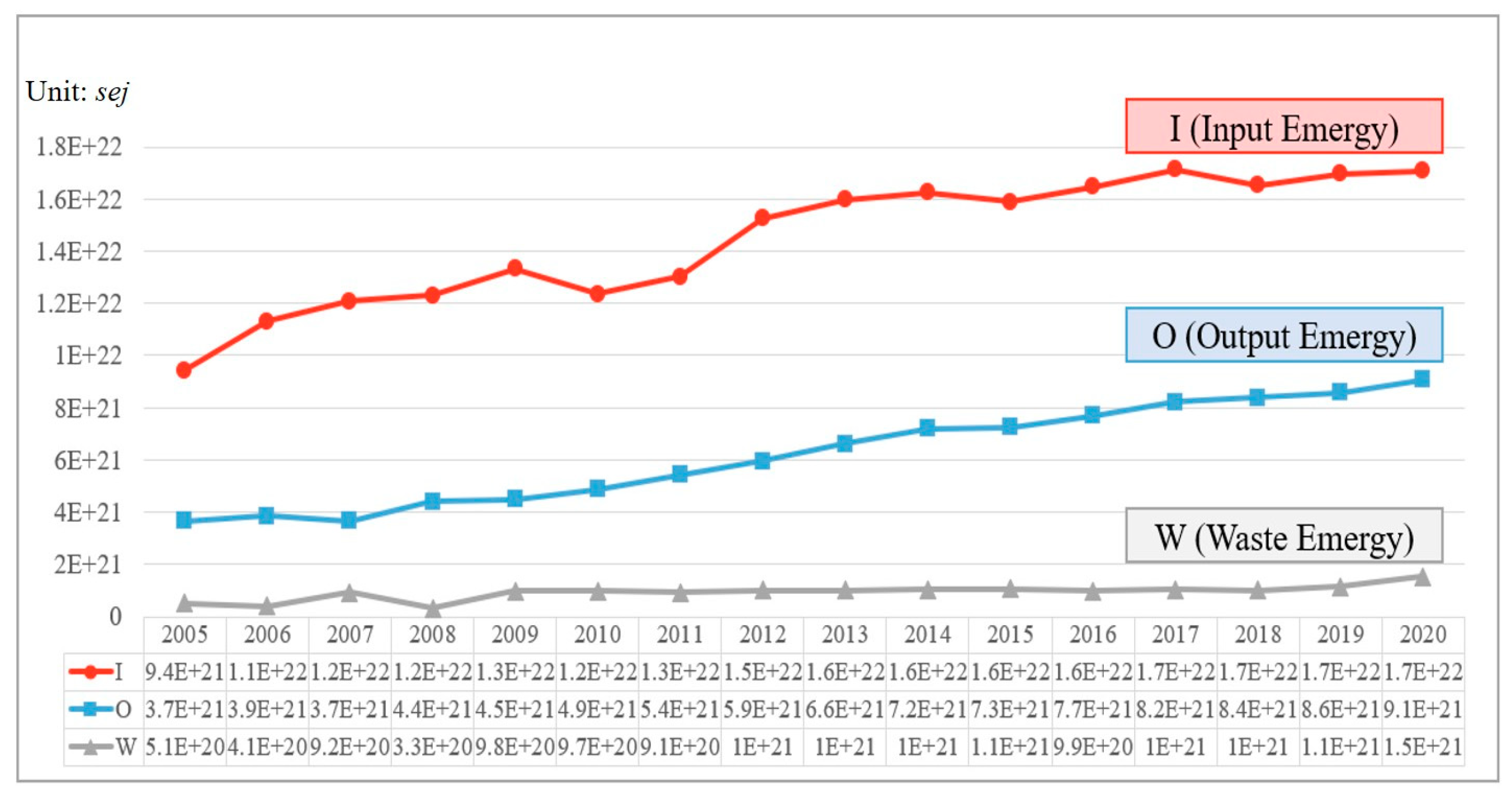
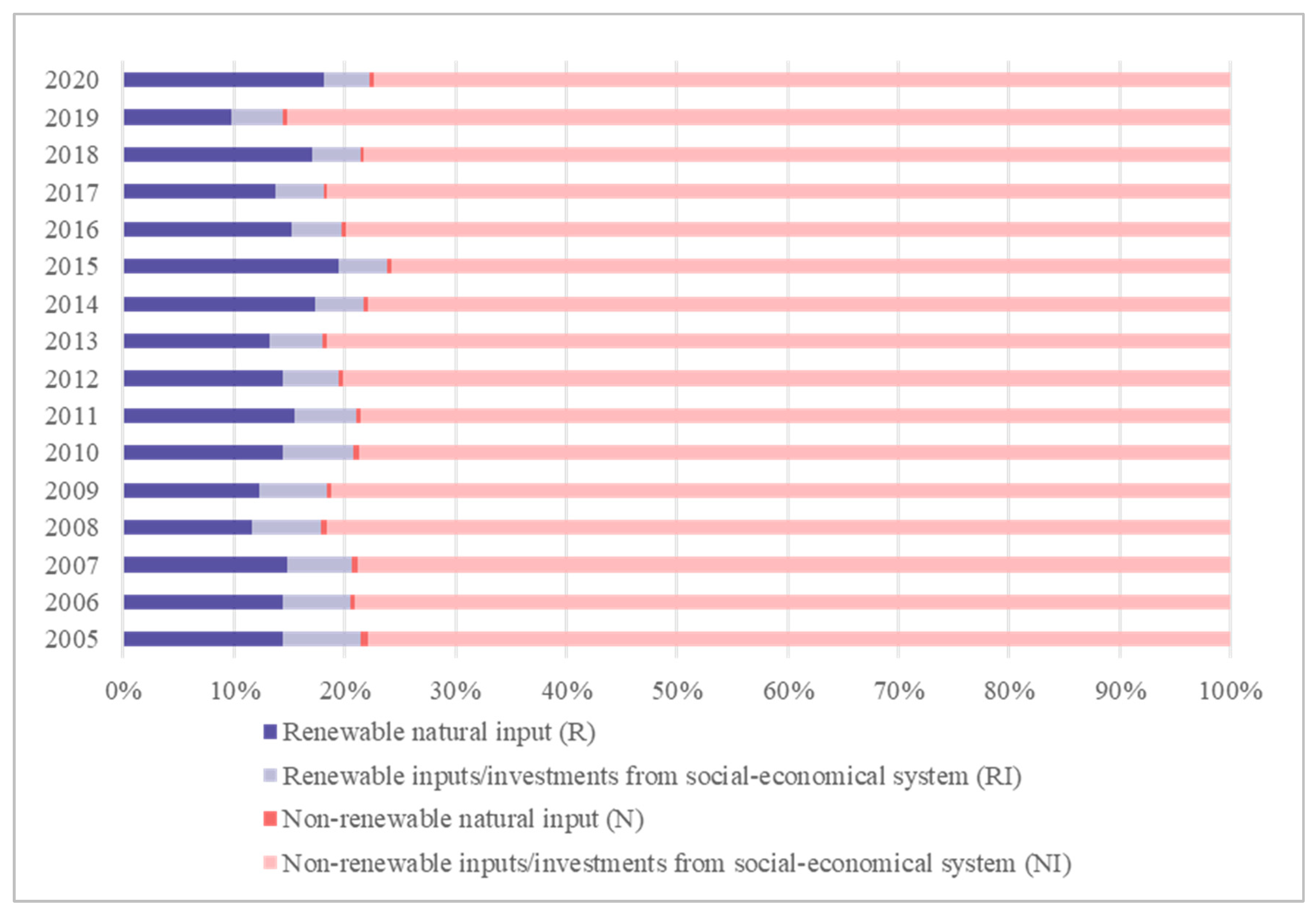
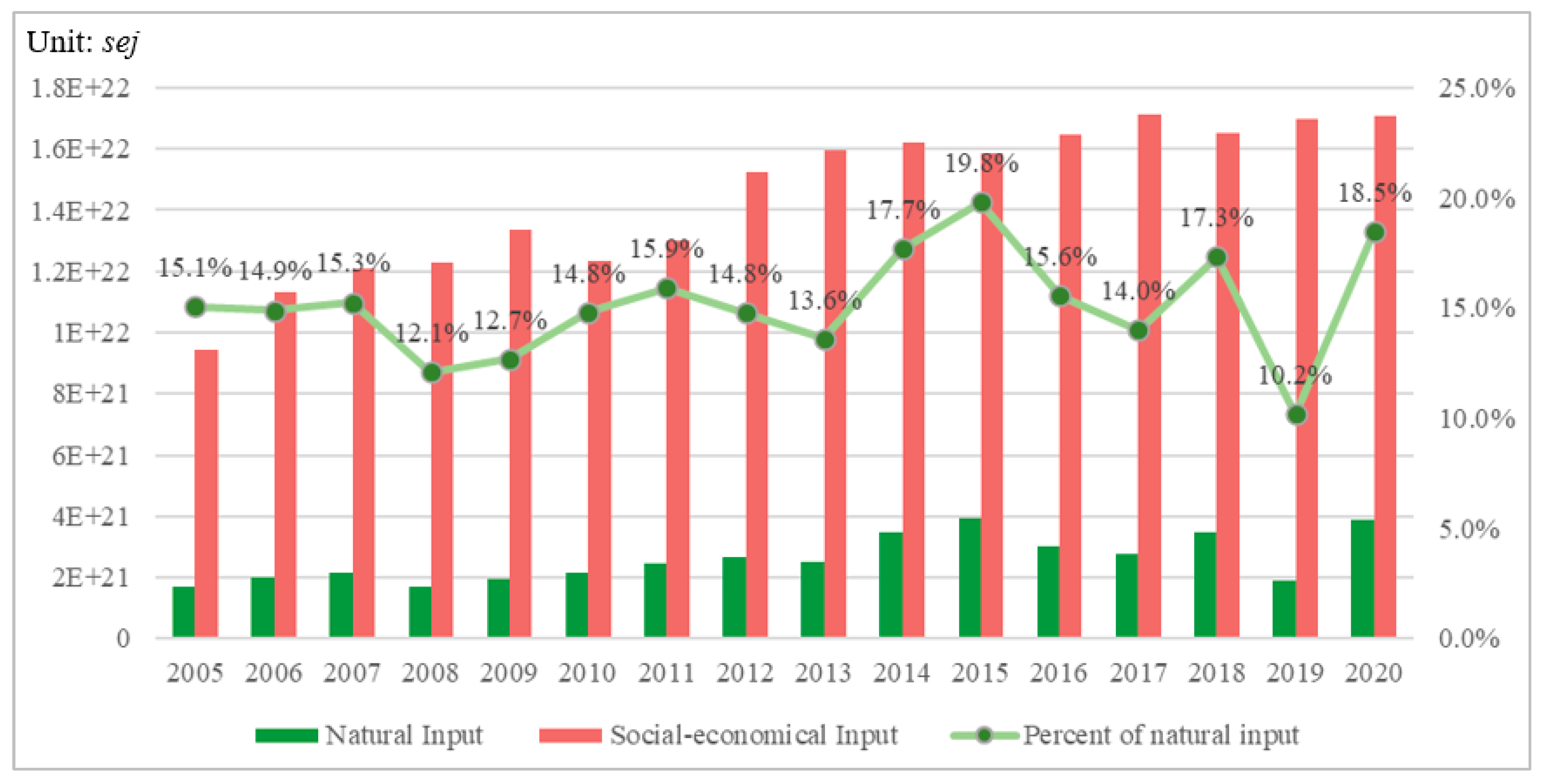
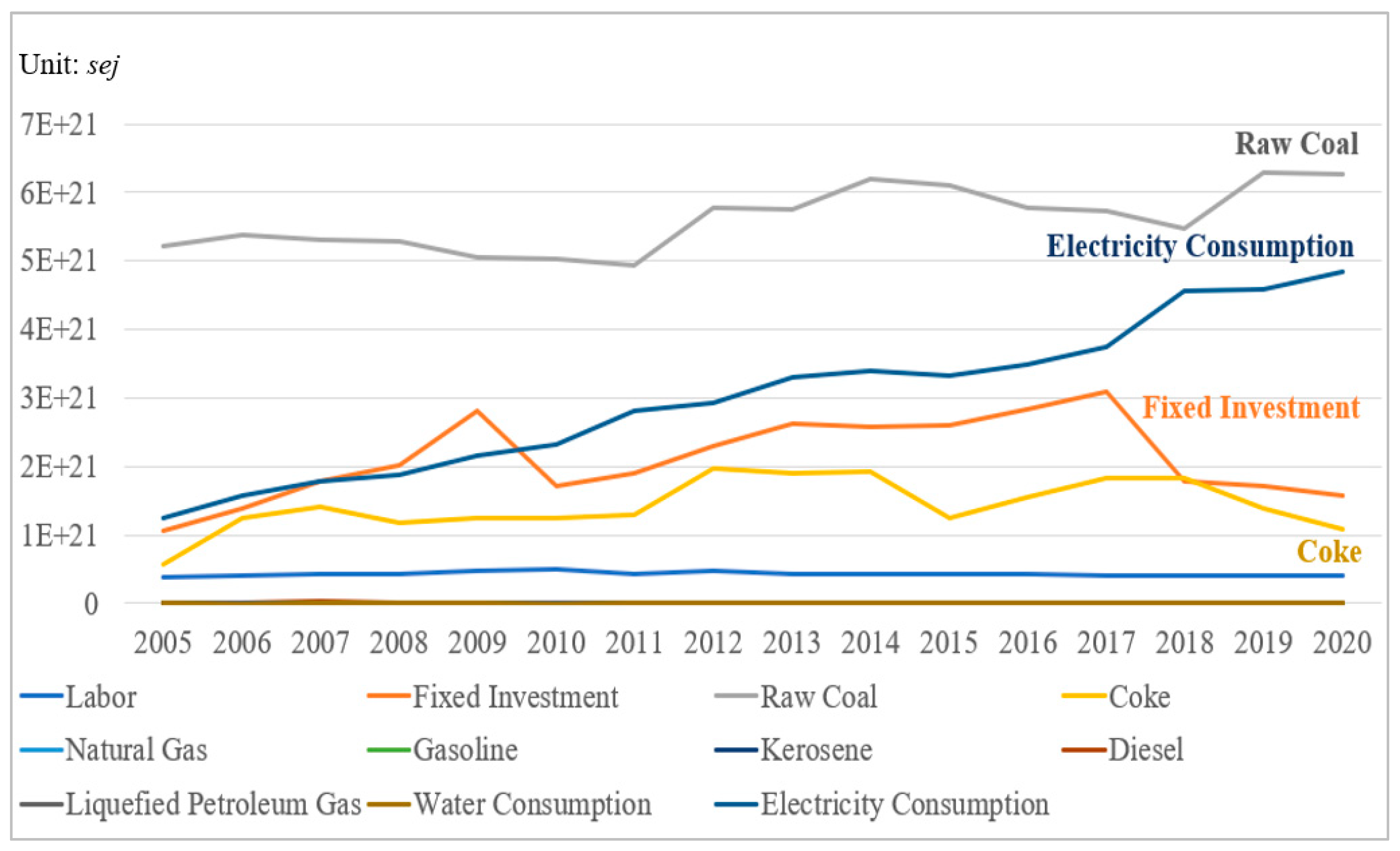


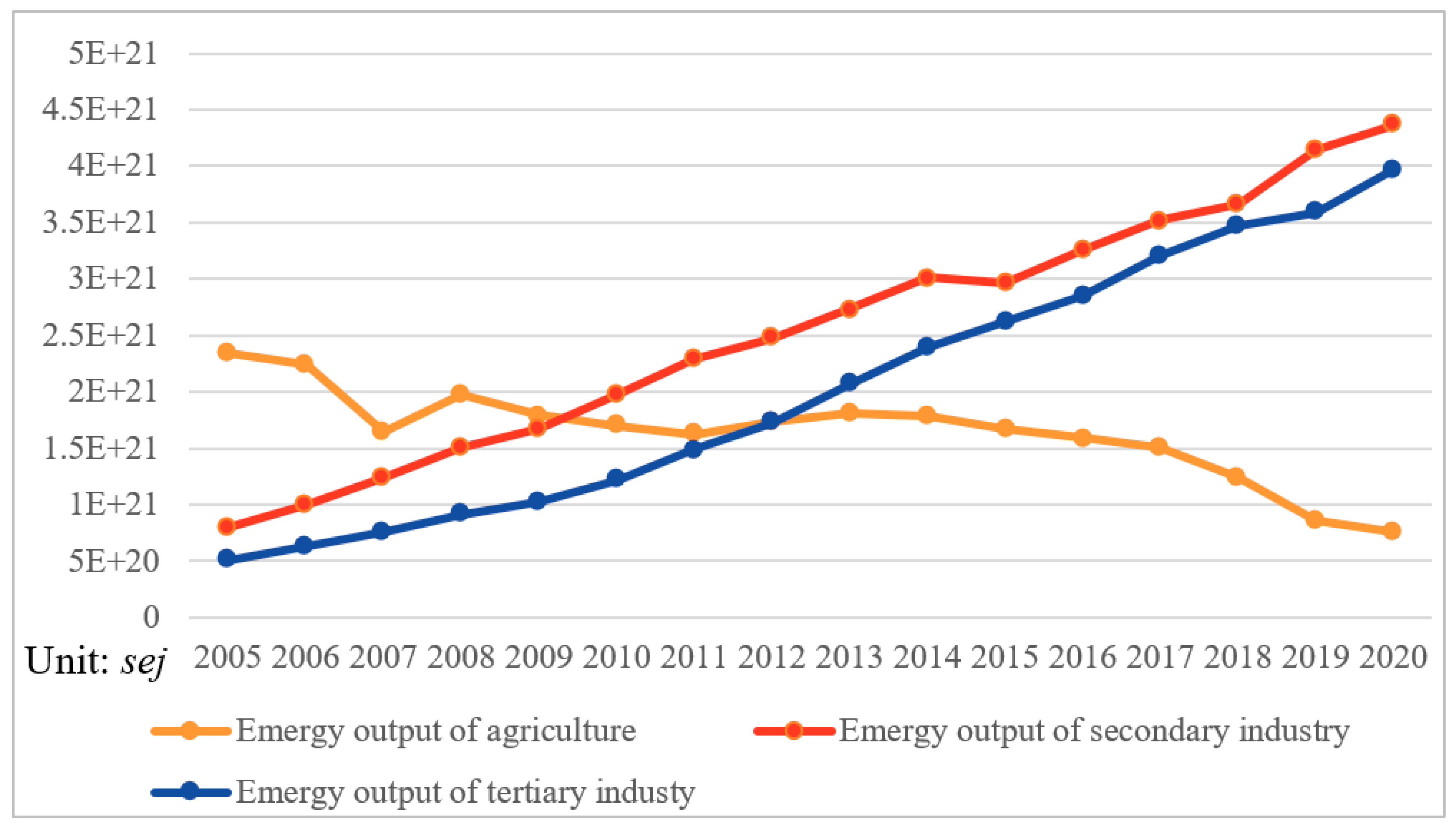
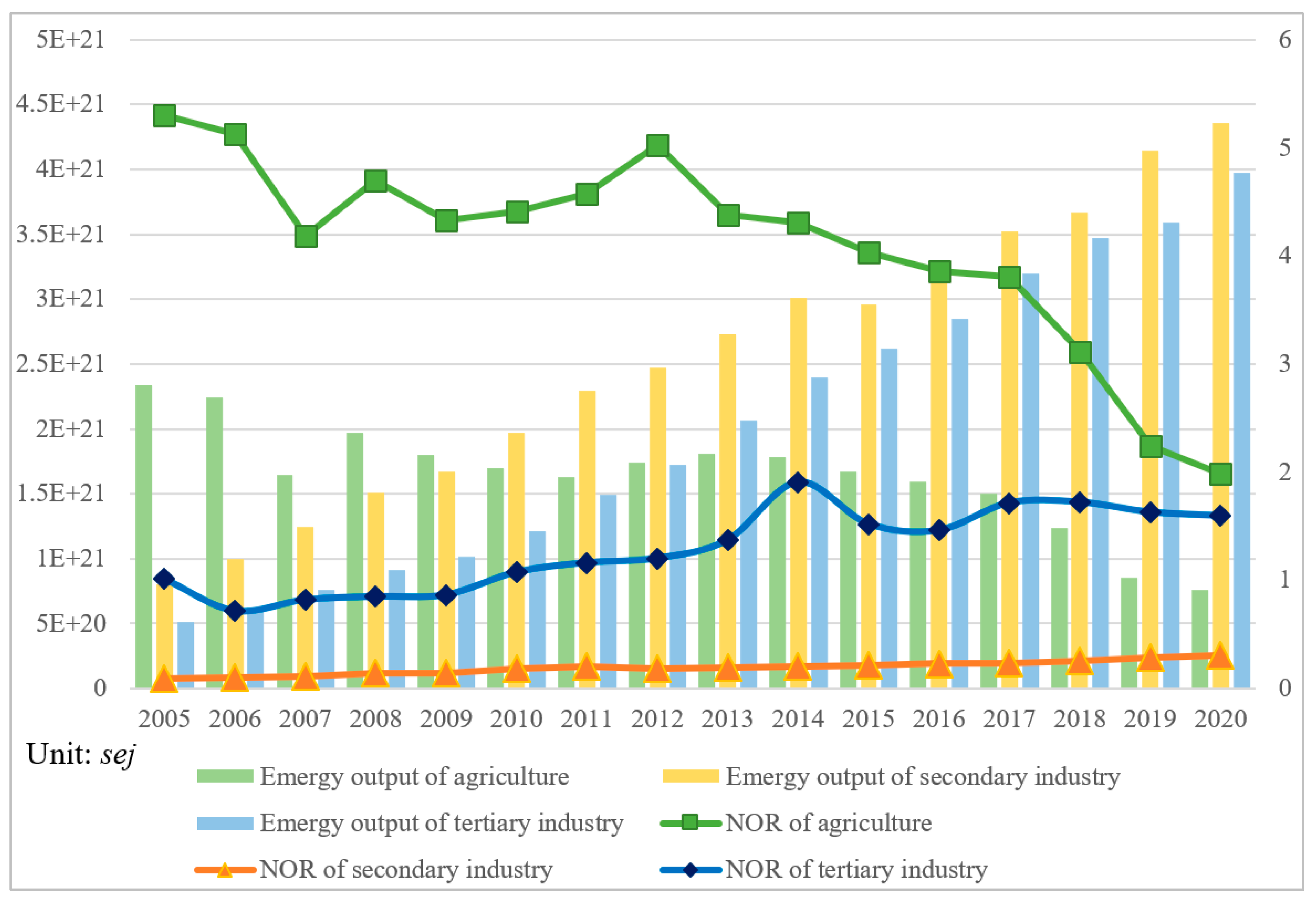
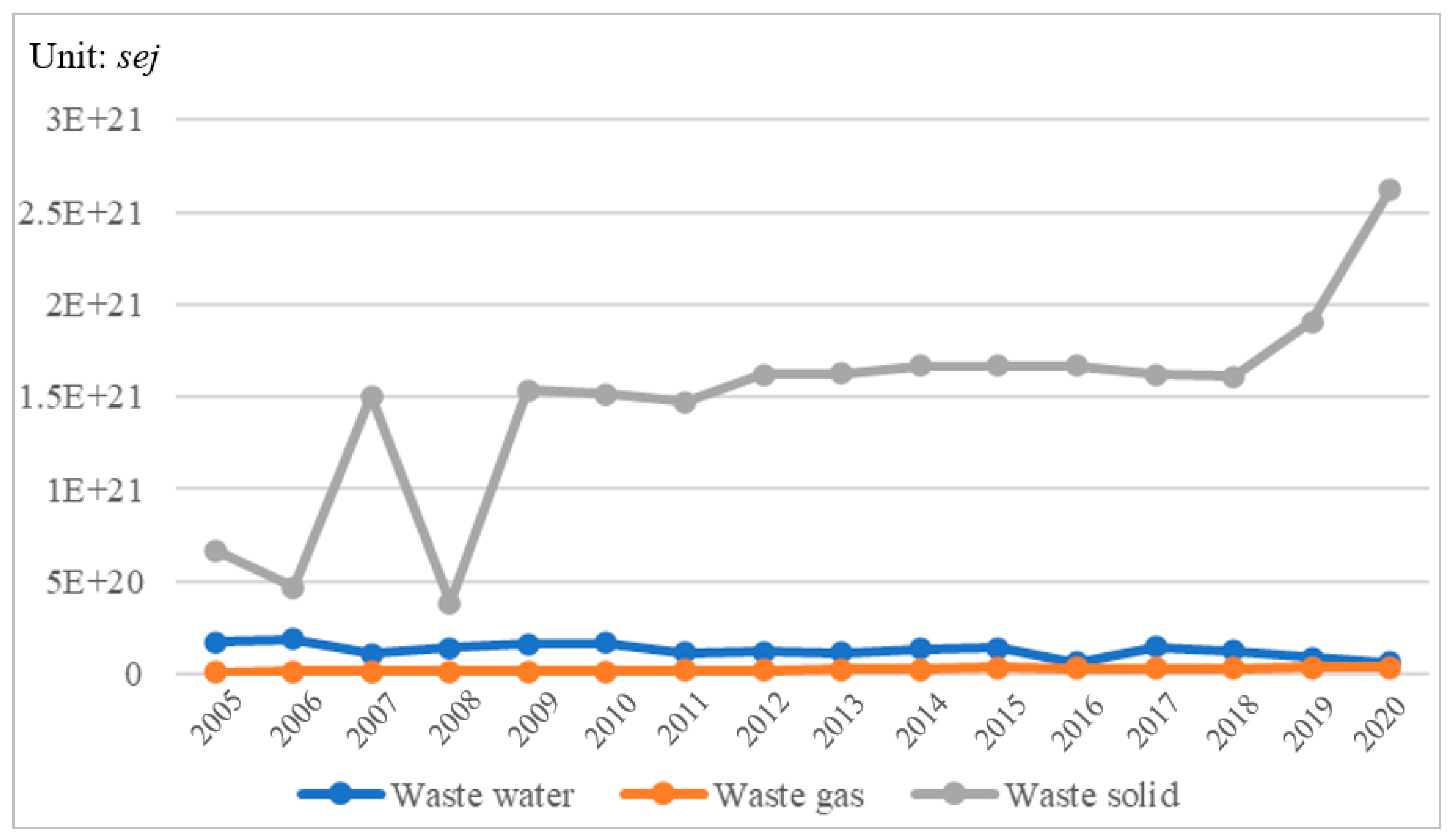
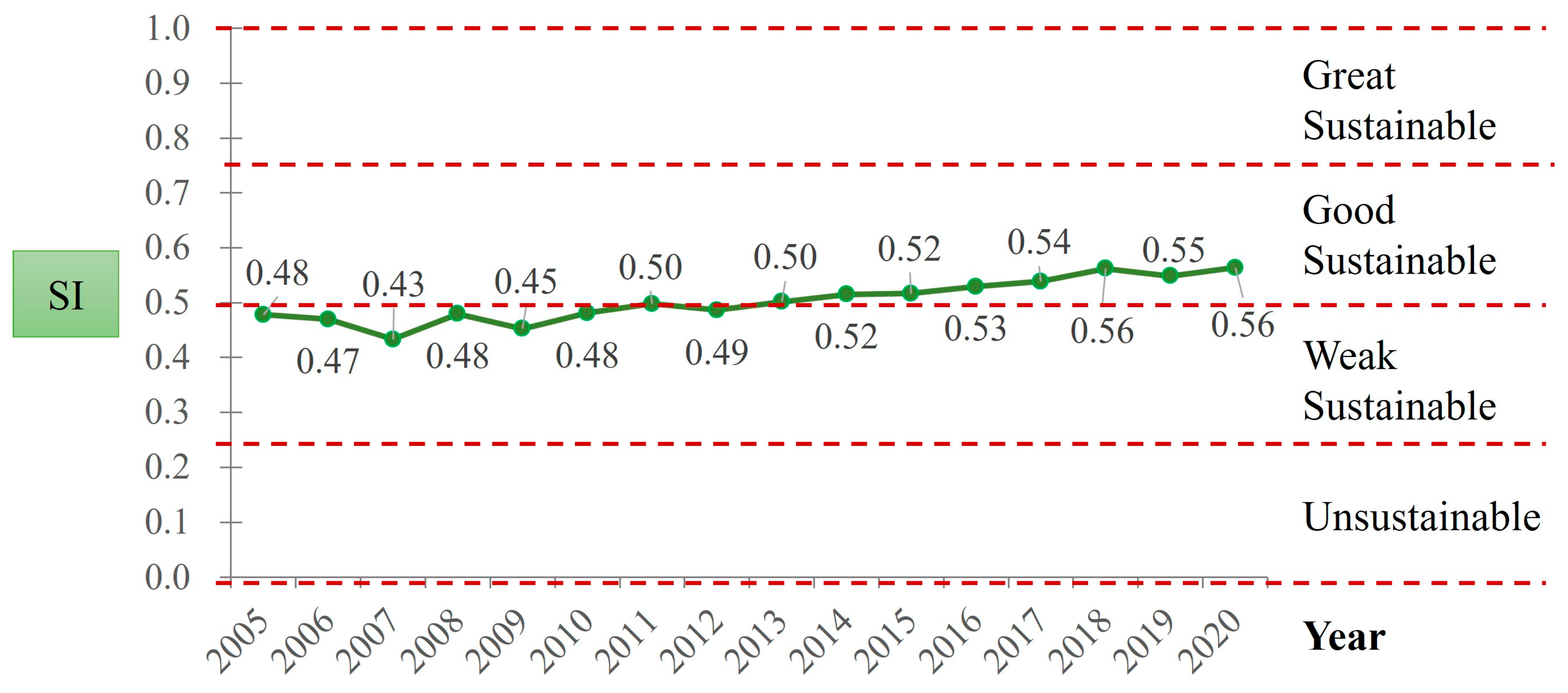
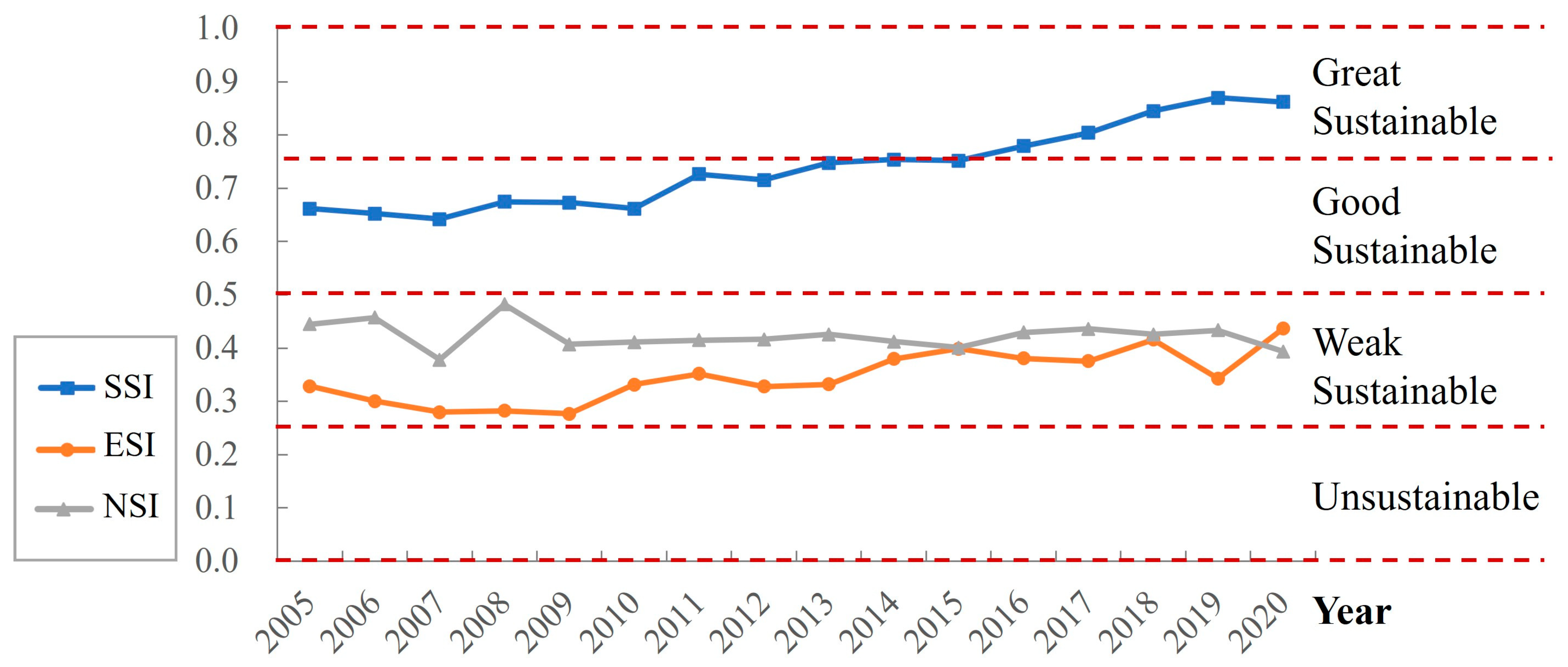
| Items | Unit | UEV (sej/unit) | Refs. | Items | Unit | UEV (sej/unit) | Refs. | ||
|---|---|---|---|---|---|---|---|---|---|
| Renewable resources emergy (R) | 27 | Liquefied Petroleum Gas | J | 111,000 | [45] | ||||
| 1 | Sunlight | J | 1 | [44] | 28 | Tourism | CNY | 80,703,633,975 | [44] |
| 2 | Wind, Kinetic Energy | J | 623 | 29 | Foreign Capital | CNY | 80,703,633,975 | ||
| 3 | Rain, Chemical | J | 4700 | Output emergy (O) | |||||
| 4 | Rain, Geopotential | J | 15,400 | 30 | GDP | CNY | 80,703,633,975 | [44] | |
| 5 | Earth Cycle | J | 29,000 | 31 | Rice | J | 35,900 | [42] | |
| Non-renewable resources emergy (N) | 32 | Wheat | J | 68,000 | |||||
| 6 | Topsoil Loss | J | 74,000 | [44] | 33 | Corn | J | 27,000 | |
| 7 | Organic Matter Loss | g | 1,700,000,000 | 34 | Bean | J | 690,000 | ||
| Input renewable emergy (IR) | 35 | Tuber Crop | J | 2700 | |||||
| 8 | Labor | J | 483,000 | [46] | 36 | Oil Crop | J | 690,000 | |
| 9 | Seeds | J | 66,000 | [46] | 37 | Cotton | J | 860,000 | |
| 10 | Organic Fertilizer | g | 3,870,000,000 | 38 | Sugarcane | J | 84,000 | ||
| Input non-renewable emergy (IN) | 39 | Vegetable | J | 27,000 | |||||
| 11 | Fixed Investment | CNY | 80,703,633,975 | [44] | 40 | Melon | J | 27,000 | |
| 12 | Total Agricultural Machinery Power | J | 202,000 | [46] | 41 | Tea | J | 254,000 | |
| 13 | Nitrogen Fertilizer | g | 5,870,000,000 | 42 | Fruit | J | 53,000 | ||
| 14 | Phosphate Fertilizer | g | 22,600,000,000 | 43 | Chinese Chestnut | J | 690,000 | [47] | |
| 15 | Potash Fertilizer | g | 2,210,000,000 | 44 | Bamboo Shoot | J | 27,000 | ||
| 16 | Compound Fertilizer | g | 3,560,000,000 | 45 | Wood | J | 44,000 | ||
| 17 | Pesticide | g | 2,060,000,000 | 46 | Bamboo | J | 44,000 | ||
| 18 | Agricultural Film | g | 483,000,000 | 47 | Pork | J | 1,710,000 | [42] | |
| 19 | Electricity Consumption | J | 159,000 | [42] | 48 | Mutton | J | 2,000,000 | |
| 20 | Water Consumption | g | 219,000 | 49 | Poultry | J | 1,710,000 | ||
| 21 | Raw Coal | J | 66,900 | [45] | 50 | Silkworm Cocoon | J | 2,570,000 | |
| 22 | Coke | J | 39,800 | [48] | 51 | Aquatic Product | J | 2,000,000 | |
| 23 | Natural Gas | J | 48,000 | Waste emergy (W) | |||||
| 24 | Gasoline | J | 66,000 | 52 | Waste Water | J | 1,120,000 | [49] | |
| 25 | Kerosene | J | 66,000 | 53 | Waste Gas | J | 1,120,000 | ||
| 26 | Diesel | J | 66,000 | 54 | Solid Waste | J | 3,020,000 | ||
| Target | Criteria | Indicators | Definition | Positive/Negative |
|---|---|---|---|---|
| Sustainable Index (SI) | Natural Sustainable Index (NSI) | Natural contribution rate (NCR) | (R + N)/(R + N + IR + IN) | + |
| Environmental carrying rate (ECR) | (N + IN)/(R + IR) | − | ||
| Waste rate (WR) | W/O | − | ||
| Social Sustainable Index (SSI) | Per capita emergy utilization (EU) | (IR + IN)/P | − | |
| Per capita emergy output (EO) | O/P | + | ||
| Per capita electricity emergy (EE) | E/P | + | ||
| Economic Sustainable Index (ESI) | The net emergy output rate (NOR) | O/(IR + IN) | + | |
| The emergy investment rate (EIR) | (IR + IN)/(R + N) | − |
Disclaimer/Publisher’s Note: The statements, opinions and data contained in all publications are solely those of the individual author(s) and contributor(s) and not of MDPI and/or the editor(s). MDPI and/or the editor(s) disclaim responsibility for any injury to people or property resulting from any ideas, methods, instructions or products referred to in the content. |
© 2023 by the authors. Licensee MDPI, Basel, Switzerland. This article is an open access article distributed under the terms and conditions of the Creative Commons Attribution (CC BY) license (https://creativecommons.org/licenses/by/4.0/).
Share and Cite
Gao, Y.; Tian, L.; Huang, A.; Zhang, H.; Yu, J.; Pan, Y.; Wang, Y.; Gou, B. Research on the Sustainable Development of Natural-Social-Economic Systems Based on the Emergy Accounting Method—A Case Study of Liyang in China. Land 2023, 12, 1362. https://doi.org/10.3390/land12071362
Gao Y, Tian L, Huang A, Zhang H, Yu J, Pan Y, Wang Y, Gou B. Research on the Sustainable Development of Natural-Social-Economic Systems Based on the Emergy Accounting Method—A Case Study of Liyang in China. Land. 2023; 12(7):1362. https://doi.org/10.3390/land12071362
Chicago/Turabian StyleGao, Yuan, Li Tian, An Huang, Huan Zhang, Jianghao Yu, Yu Pan, Yuankang Wang, and Binzhuo Gou. 2023. "Research on the Sustainable Development of Natural-Social-Economic Systems Based on the Emergy Accounting Method—A Case Study of Liyang in China" Land 12, no. 7: 1362. https://doi.org/10.3390/land12071362





